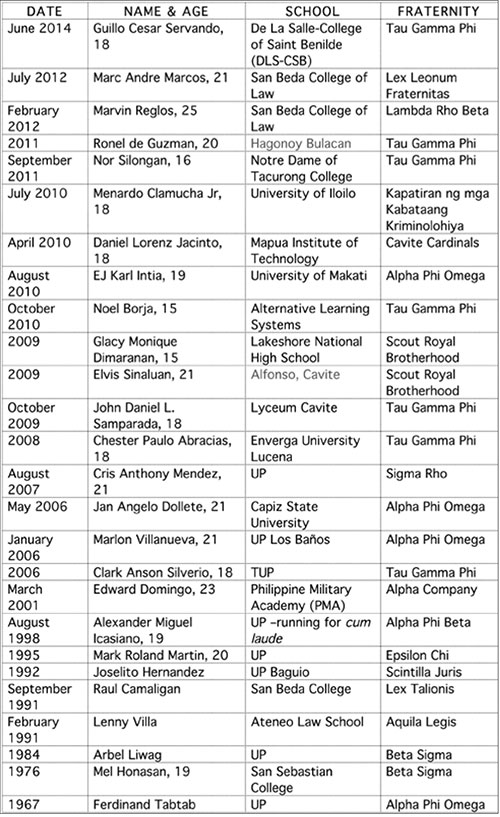Haze
I have commented about fraternity-related violence in previous columns (see October 2, 2010, August 4 and 11, 2012) but as the problem persists, we have to continue writing about it. Truly, the loss of, or injuries inflicted upon, young and innocent lives is senseless and must be stopped.
UP Manila Chancellor Michael Tan used a similar title in his column in the other paper the other day. But his haze dealt with the physical and psychological effects of hazing. He observed that there is no such thing as “mild” hazing and in fact, the current practice of hitting clothed or concealed body parts can be more dangerous in the long run. Moreover, the psychological trauma can be long lasting as well with a potential impact on an individual’s self-esteem and view of the world. In other words, after being hazed, a victim can be dazed.
My haze deals more with memory and the time it takes to bring the perpetrators to account for their misdeeds. While the number of victims continues to escalate, many of the cases filed against those responsible for the violent hazing end up in legal limbo. And after an initial uproar, the victims tend to be forgotten. When this happens, they become mere statistics and further dehumanized. The question is two-fold: 1) when will the carnage stop? (or to be more realistic, for just like the use of illegal drugs, I am not sure whether the practice can be completely eradicated, when will it subside) and 2) when will justice be served? Speaking of statistics, I surfed the internet for the names of past victims and the table below presents a summary of my preliminary findings:

I tried to research the status of the investigation or case involving these victims but with the exception of a few, could not find any. It is however safe to assume that many of these cases are either still pending in court or worse, dismissed. Also this list does not include victims of fraternity wars. In 1969, 1977 and 1994, Rolando Perez, Rolando Abad and Dennis Venturina, respectively, were attacked and killed by members of rival fraternities. In 1999, Niño Calinao, a non-frat member senior journalism student at UP was shot dead after being mistaken to be a member of a rival frat. Less than a year later, third-year engineering student Den Daniel died of multiple stab wounds after a clash between rival fraternities near the UP Law Center. Ironically on that same evening, a concert was being held to honor the memory of Niño Calinao.
During the traditional “salubong” which happened on the last Sunday of the 2010 bar examinations, law student Raissa Laurel lost her two legs in a fraternity-related grenade blast. This led me to remark that in law school, non-frat members are referred to as “barbarians.” But with these kinds of incidents, you wonder which group really deserves the title.
As a segue to last week’s “First thing we do, let us kill all the lawyers” column, this week’s mantra should be “First thing we do, let us save all the lost students.”
* * *
Kissing lawyers: He used to be one of the young firebrand lawyers that we law students looked up to but has now joined the ranks of wise men of the law that he once idolized. Former Senator Rene Saguisag commented that President Marcos should have followed the Shakespearean adage of eliminating lawyers such as Diokno, Tañada and Salonga who kept raising the foolish questions of the day during martial law. But he preferred a variation which appeared in a William Safire column many years ago, “first thing we do, let’s kiss all the lawyers.”
* * *
“It has been said, ‘time heals all wounds.’
I do not agree. The wounds remain. In time,
the mind, covers them with scar tissue and the pain lessens. But it is never gone.” – Rose Kennedy
Email: [email protected]
- Latest
- Trending


























